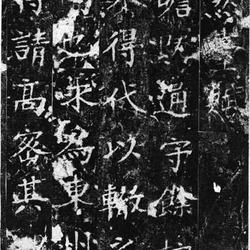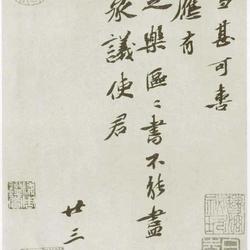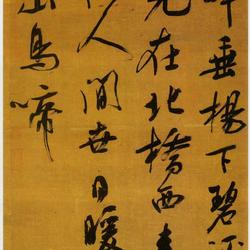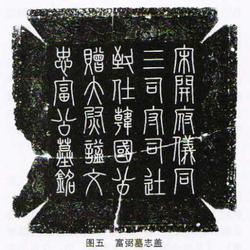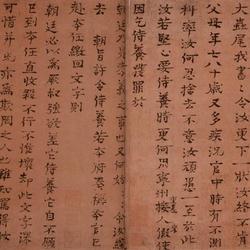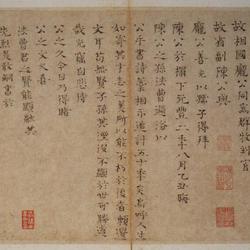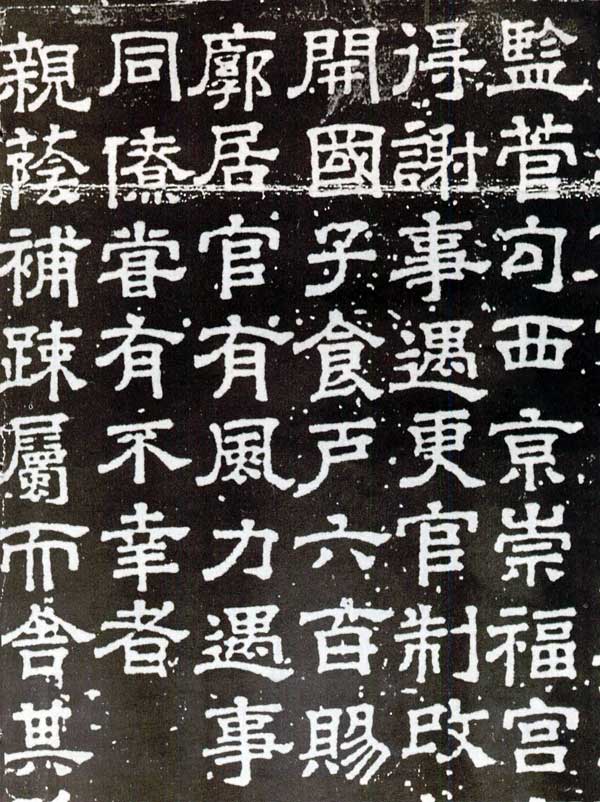
Sima Guang's official script "Wang Shanggong's Epitaph" (detail)
"Wang Shanggong's Epitaph" was unearthed in Beichenzhuang, Luoyang in 1936, and was carved in October of the seventh year of Yuanfeng in the Song Dynasty (1084). The stone is square in shape, with a length and width of 77cm and a thickness of 15cm. The Zhiwen is in official script, divided into upper and lower columns, each column has 41 lines and a full line of 20 characters. The full name of "Wang Shanggong's Epitaph" is "The Epitaph of Wang Shanggong, a senior official in the Song Dynasty who became an official in the royal palace". The epitaph was written by Fan Chunren, the son of Fan Zhongyan, a famous official in the Song Dynasty, and engraved by the famous historians Sima Guangshudan and Li Zhen. "Wang Shanggong's Epitaph" is a famous record from the Song Dynasty and has high historical material and calligraphy artistic value.
Wang Shanggong, "History of the Song Dynasty" has no biography. The epitaph of Wang Shanggong is recorded in the Collected Works of Fan Chunren. In addition, in the two books "Song Shi Yi" and "Song and Yuan Academic Cases Supplement", the deeds about Wang Shanggong all come from Zhiwen. It can be seen that "Wang Shanggong's Epitaph" is the most detailed and precious first-hand material for understanding and studying Wang Shanggong, which can fill the gap in historical records.
The record of Wang Shanggong's ancestral home in the epitaph is completely consistent with the historical records. The epitaph says: "The Duke first established his family in Jingzhao for ten thousand years, and then his family was in Guozhou. When the emperor was imperial examination, his first home was Henan." Wang Shanggong's father, Wang Ji, is called "Shang Shugong" in his epitaph. Wang Ji's "History of the Song Dynasty" also has no biography. According to the inscription on Wang Ji's tomb recorded in Jun Zhu's "Yin Henan Collection": "Ji Zishi An, his ancestral home was Jingzhao for ten thousand years, his family was in Guozhou, and he later moved to Henan." Chi and history can corroborate each other.
The epitaph records: "On August 9, the seventh year of Yuanfeng, the imperial court official became a prince, and died of illness in Jiashan, the Western Capital, at the age of seventy-eight... On October 9, he was buried in Heqing County, Henan Prefecture. Go to the store...". "The official taboo is Shang Gong, and the word is Anzhi... Shaoxiu and his younger brother Shang Xing went to Xiangxu together, and they liked to be friends with the wise men and officials... In the first year of Jing Xing's reign, the brothers entered the Jinshi Department together." Later, Shang Gong was appointed as the judge of Qingcheng Army. He had knowledge of Ruicheng, Yangwu and Houshi counties, and he was appointed as a court official. Shang Gong "has a timid nature, a broad-minded attitude, a strong sense of authority in his position as an official, must take responsibility for things he encounters, does not take things for granted, and is good at communicating with others..."
During his tenure, Wang Shanggong wrote a letter to the court through Fan Zhongyan in order to express his political views of eliminating bad government and enriching the country and strengthening the army: "It is better to select generals and entrust them with no doubts, and blame them for their great achievements and forgive their small ones to inspire their loyalty." The expense is to deprive the ministers of offering sacrifices to the dead in the suburbs, so as to broaden the country's use. Choose to keep the order carefully and simplify the prevention and prohibition. Appoint officials first and then the regular ones, appoint chief officials, and eliminate redundant personnel to save trouble. Reduce inspections, increase archers, and prohibit prohibitions. Steal...". These practical and reliable suggestions were appreciated by Fan Zhongyan. When defending Xixia's attack on Song Dynasty, Shang Gong made many suggestions and achieved good results in annihilating the enemy.
When Wang Shanggong was the magistrate of Wuyang County, Bao Zheng was the governor. Bao Zheng "loved the public and was wise". Once, when a lawsuit handled by Shang Gong was brought against Bao Zheng again, Bao Zheng said: "Since the king has decided it, why bother to appeal again?" It can be seen that Wang Shanggong's ability and talent in handling cases are very outstanding. Enforcing the law impartially and not following personal feelings is also worthy of people's trust.
The last part of the epitaph records: "...the Duke is old...he entertained himself with literature and wine with the wise men and wise men in the village. Therefore, the rich Duke of South Korea, now the Duke of Lu State, was loved by the left-behind Prime Minister Han Gong and the left-behind princes of the Northern Capital. Lu Gong loved to meet him. The senior people who gathered old virtues were called the Qiyinghui. There were twelve people who painted his portrait and wrote poems, and the public ranked fourth. He ordered the public to write his poems on the stone. His writing power was strong and strong, and he was beyond his prime. He wrote thousands of poems in his life. Most scribes love it..." This record shows that after returning to his hometown, Wang Shanggong was included in the list of sages and sages and was a member of the "Senior Elite Association" in Luoyang. The "Senior Young People's Club" was when Wen Yanbo stayed in Luoyang, the western capital, where he gathered old scholar-bureaucrats to have fun. It was called the "Luoyang Senior Young Scholars Club" at that time. "Mengxi Bi Tan·Volume 9" records the origin of the Senior Citizens' Association, its members and their order. There are 13 members in the Senior Citizens Association, and the order of ranking is mainly based on age. The oldest member is 77 years old, and Wang Shanggong is 76 years old, ranking fourth. This is consistent with historical records. The difference is that the Zhiwen records that there are 12 members of the Senior Citizen Association. Why is there one person different between the records in the history books and the Zhiwen? According to Wang Jieren's "Zhongzhou Zazu": "Although Sima Guang participated in the Senior Elite Meeting, he was sixty-four and less than seventy years old. According to the story of Bai Juyi and the Nine Elders, he was a non-voting guest." Another Zhiwen was Sima Guang Shudan, which may have a meaning of humility. , so it is not included. Therefore, Zhiwen records it as "twelve people".
The above articles describe Wang Shanggong as an open-minded, frank, resourceful and honest official. After returning to his hometown in old age, he took up the fourth most important position in the Senior Citizens Association. After his death, important officials of the imperial court wrote articles and erected monuments for him. This shows that Wang Shanggong had the same political views and interests as Sima Guang, Wen Yanbo and others who opposed Wang Anshi's reform. Although there is no record of Wang Shanggong in the history books, it is not difficult to see from the chronicles that Wang Shanggong was not an unknown person at that time, but a famous and influential figure.
"Wang Shanggong's Epitaph" is a collection of famous people's writings, famous calligraphy and elixirs, and famous teachers' engravings. In particular, Sima Guang Shudan's Zhiwen is more favored by calligraphers. Although Sima Guang is famous for his history and not for his calligraphy, his calligraphy was unanimously recognized by people, especially the scholar-bureaucrats at that time. There are not many physical examples of Sima Guang's works in existence today. There are more than 10 pieces of ink ink, engraved calligraphy and stone carving, including regular script and official script. Judging from documentary records, Sima Guang's official script was quite famous at the time. Huang Tingjian's "On Calligraphy" said: "Justice Wen's calligraphy is not very good, but his official script is extremely vigorous, as if he was a person...". It is recorded that Emperor Gaozong of the Song Dynasty said: "The characters in Sima Guang's official script are really like those of the Han people. In recent times, Mi Fu's generation cannot be like them. I have five volumes of Guang's official script, and I can't stop playing with his characters day and night." Zhu Yizun quoted from "Song Jian" in the late Ming and early Qing dynasties. Emperor Gaozong of the Song Dynasty collected records in five volumes of Sima Guang's official script "The Doctrine of the Mean" and "Family".
Why was Sima Guang so good at and so fond of official script? This is because he is extremely interested in the study of calligraphy, painting and epigraphic archeology. He is also influenced by the orthodox calligraphy ideas inherited from the Han and Tang dynasties, which regard official script inscriptions as quaint and solemn rather than regular script. Sima Guang's ink and engravings handed down from generation to generation are all in regular script. The only official scripts of Sima Guang that can be seen today are the "Family" hexagram on the cliff of Xingjiao Temple in Nanpingshan, Hangzhou, Zhejiang, the "Family" hexagram on the cliff of Laojun Cave, Rongshui, Guangxi, and the "Family" hexagram on the cliff in Xia County, Shanxi "Title of Yuwang Temple" and "Wang Shanggong's Epitaph" collected by Kaifeng Museum. Among them, "Wang Shanggong's Epitaph" has clear characters and complete preservation, and can represent the highest level of Sima Guang's official script.
"Wang Shanggong's Epitaph" is an epitaph written by Sima Guang in his later years. The layout of the memorial stone is divided into upper and lower columns. This form may have been in the form of a hand scroll when writing this memorial, so the copy on the square memorial stone had to be divided into upper and lower columns. In this way, the layout of Zhishi is clear and bright, and the form is novel and unique. As far as Sima Guang's calligraphy is concerned, the calligraphy method of this epitaph is not high. It seems to have inherited "inscription stones" such as Cao Wei's "Wang Ji's Remnant Stele". Therefore, its authenticity is not as good as that of Han Li, and its beauty is not as good as that of Tang Li. However, its usefulness The strokes are square and cut, the strokes are strong and penetrating, the strokes are deep and strong, and the structure is mostly vertical. Although the font is small, it is full of spirit. At the turning point, there is a sharp edge, a balance between hardness and softness. The lines intersect with straight arcs, which is very beautiful in its simplicity. In addition to the legal system, it also has the meaning of regular script. It does not have the shortcomings of fatness that are common in Tang Dynasty officials. It has a graceful and powerful style without anger. At a time when people in the Tang Dynasty favored law and people in the Song Dynasty favored ideas, it can be described as a rare masterpiece . Looking at the whole article, it is simple, mao, ancient and powerful, revealing a strong atmosphere of gold and stone.
Although Sima Guang is not world-famous for his calligraphy, he was able to draw on the strengths of other schools based on his personal vision, integrating the solemnity of Han Li, the subtleties of Jin people, and the robustness of Tang Kai to form a distinct personal appearance and style. , is also unique among Song calligraphy.

